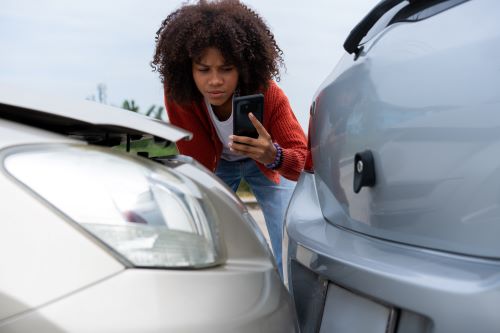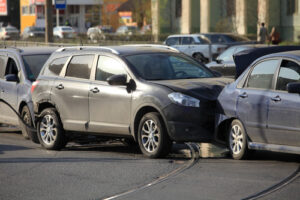In the chaotic moments following a car accident, knowing what to do can be overwhelming. Amid the stress, confusion, and adrenaline, one crucial step that is often overlooked is documenting the scene through photographs. Taking pictures at the accident scene isn’t just a helpful tip—it can play a pivotal role in protecting your rights, ensuring fair insurance claims, and providing critical evidence in the event of legal disputes.
Taking photos at the scene of a car accident is a critical step in protecting your rights and building a strong claim. These images can provide valuable evidence to support your case, especially when working with an experienced Atlanta car accident attorney who can guide you through the legal process and ensure you receive fair compensation for your damages.
What to Photograph at the Accident Scene
Taking photos at the scene of a car accident is essential for building a strong claim. These images serve as valuable evidence that can clarify the circumstances surrounding the accident. Here’s what you should focus on capturing:
The Vehicles Involved
Start by photographing all vehicles involved in the accident. Get clear shots from different angles to show the extent of the damage. This includes close-ups of any dents, scratches, or broken parts. These images can help establish the severity of the collision and may be crucial for your insurance claim.
Surrounding Area and Traffic Signals
Document the surrounding area where the accident took place. Take pictures of nearby traffic signals, street signs, and road conditions. These details can provide context for the accident. For instance, if a yield sign was obscured, this may indicate contributing factors to the incident.
Skid Marks and Other Road Evidence
If there are skid marks or debris on the road, be sure to photograph these as well. Skid marks can indicate the speed of the vehicles involved and how the accident occurred. Capturing this evidence can strengthen your case by illustrating the dynamics of the crash.
Weather Conditions
Weather can play a significant role in accidents. Take photos that show the current weather conditions, such as rain, fog, or snow. This documentation can be important in understanding the factors that contributed to the accident and can influence liability assessments.
Injuries Sustained
If it is safe and appropriate to do so, photograph any visible injuries you or your passengers sustained. This visual evidence can support your claim and highlight the impact of the accident on your life.
Other Relevant Details
Finally, capture any other details that may be pertinent to your case. This could include nearby security cameras, the position of the vehicles, and the overall scene. Every piece of evidence can play a significant role in establishing a clear picture of what happened.
Preserving Evidence with Accident Scene Photos
Taking pictures at the scene of a car accident is vital for preserving evidence. These photographs serve as critical documentation that can support your lawsuit. When you capture the scene, you create a visual record that may prove essential later on.
Importance of Immediate Documentation
The immediate aftermath of an accident is often chaotic. Emotions can cloud judgment, making it hard to remember every detail. By taking pictures, you can document the accident context accurately. This includes the position of vehicles, road conditions, and any visible injuries. These images become valuable evidence that can clarify what happened during the incident.
Key Elements to Capture
When photographing the accident scene, focus on several key elements:
- Vehicles Involved: Take clear shots of all vehicles involved, showing their positions and damage. Different angles can provide a comprehensive view of the accident.
- Traffic Signs and Signals: Document nearby traffic signs, signals, and any relevant road markings. This can help establish the context of the accident and any potential violations.
- Surrounding Area: Capture images of the surrounding area, including weather conditions and visibility. These factors can influence the circumstances of the accident.
- Injuries Sustained: If you or anyone else sustained injuries, photograph these as well. This visual evidence can be crucial in demonstrating the extent of harm suffered.
Organizing Your Photos
Once you’ve taken pictures, organize them for easy access. Label each image with details such as the time and location. This organization will help when you discuss your case with an attorney or insurance adjuster.
Establishing Fault and Liability Through Visual Evidence
When it comes to a car accident claim, establishing fault is vital. Photographs taken at the accident scene can serve as significant evidence to clarify what occurred. Visual evidence can make a compelling case, showing exactly how the accident happened and who was responsible.
Capturing the Vehicles Involved
Start by taking pictures of all vehicles involved in the accident. Focus on the position of the cars, any visible damage, and their proximity to one another. These details can help illustrate how the accident unfolded. For instance, if the other driver ran a red light, showing the position of their vehicle in relation to traffic signals can be crucial.
Documenting Surrounding Conditions
Next, capture the surrounding environment. This includes nearby traffic signs, signals, and road conditions. If there were any contributing factors, such as poor weather or obstructed views, these images can provide context to your case. Documenting these elements can help demonstrate that external conditions played a role in the accident.
Highlighting Evidence of Negligence
If there are any indications of negligence, such as skid marks or debris from the crash, be sure to photograph them. These details can support your claim by showing how the other driver acted irresponsibly. Visual proof of these factors can strengthen your argument when dealing with insurance adjusters or in court.
Taking Photos from Different Angles
To provide a comprehensive view, take photos from various angles. This approach helps capture the full scope of the accident scene. Different perspectives can reveal important details that may not be visible from a single angle. Additionally, these varied shots can help paint a clearer picture of the events leading up to the accident.
Importance of Time and Date Stamps
Lastly, ensure that your camera’s settings include time and date stamps. This information can be vital in establishing when the accident occurred. Accurate timestamps can help corroborate your account of the incident and provide a timeline for your case.
Documenting Specific Details for Your Car Accident Claim
After a car accident, taking pictures can provide critical evidence for your claim. It’s important to capture specific details that can help establish the context of the accident and support your case. Here are some key elements to focus on:
Vehicles Involved
Start by photographing all vehicles involved in the accident. Capture different angles to show the extent of vehicle damage. Close-ups of broken glass, dents, and scratches can be valuable evidence. Don’t forget to document the license plates and any identifying marks on the vehicles.
Surrounding Area
Take pictures of the accident scene to give context. This includes nearby traffic signs, signals, and road conditions. If there are any skid marks, photograph them as well. These details can help illustrate how the accident occurred and whether any contributing factors were present, such as weather conditions or obstructions.
Injuries Sustained
If you or any passengers sustained injuries, document those as well. Take clear photos of visible injuries, such as bruises or cuts, as they can serve as evidence of the impact of the accident. This can be important for your lawsuit, as it helps demonstrate the severity of your injuries and the need for medical treatment.
Witnesses and Their Statements
If there are witnesses at the scene, take pictures of them if possible. Document their contact information and any statements they provide about the accident. Their accounts can be crucial in establishing fault and liability in your case.
Important Details
Don’t overlook other relevant details. This includes photographing any debris from the accident, the positioning of vehicles, and even the weather conditions at the time. Each of these elements can contribute to a clearer understanding of the events leading up to the accident.
Consult With an Experienced Car Accident Attorney ASAP!
If you’ve been involved in a car accident, don’t navigate the aftermath alone. Taking the right steps, including capturing critical evidence at the scene, can make all the difference in your claim. Our experienced team at Ross Moore Law is here to help you every step of the way. Let us review your case, fight for your rights, and ensure you receive the compensation you deserve.
Contact us at 404-445-8122 for a free case consultation today!





